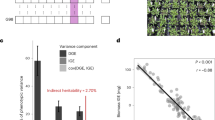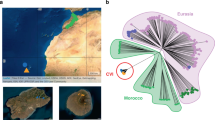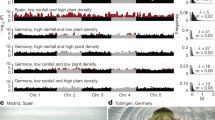Abstract
Rapid phenotypic evolution of quantitative traits can occur within years, but its underlying genetic architecture remains uncharacterized. Here we test the theoretical prediction that genes with intermediate pleiotropy drive adaptive evolution in nature. Through a resurrection experiment, we grew Arabidopsis thaliana accessions collected across an 8-year period in six micro-habitats representative of that local population. We then used genome-wide association mapping to identify the single-nucleotide polymorphisms (SNPs) associated with evolved and unevolved traits in each micro-habitat. Finally, we performed a selection scan by testing for temporal differentiation in these SNPs. Phenotypic evolution was consistent across micro-habitats, but its associated genetic bases were largely distinct. Adaptive evolutionary change was most strongly driven by a small number of quantitative trait loci (QTLs) with intermediate degrees of pleiotropy; this pleiotropy was synergistic with the per-trait effect size of the SNPs, increasing with the degree of pleiotropy. In addition, weak selection was detected for frequent micro-habitat-specific QTLs that shape single traits. In this population, A. thaliana probably responded to local warming and increased competition, in part mediated by central regulators of flowering time. This genetic architecture, which includes both synergistic pleiotropic QTLs and distinct QTLs within particular micro-habitats, enables rapid phenotypic evolution while still maintaining genetic variation in wild populations.
This is a preview of subscription content, access via your institution
Access options
Access Nature and 54 other Nature Portfolio journals
Get Nature+, our best-value online-access subscription
$29.99 / 30 days
cancel any time
Subscribe to this journal
Receive 12 digital issues and online access to articles
$119.00 per year
only $9.92 per issue
Buy this article
- Purchase on Springer Link
- Instant access to full article PDF
Prices may be subject to local taxes which are calculated during checkout





Similar content being viewed by others
Change history
05 December 2017
In the version of this Article previously published, there was a typographical error (‘4’ instead of ‘2’) in the equations relating F ST and effective population size (N e) in the Methods section ‘Genome-wide scan for selection based on temporal differentiation’. The correct equations are given below. $${F}_{{\rm{ST}}}\approx \frac{T}{T+2}=\frac{\tau }{\tau +2{N}_{{\rm{e}}}}$$ F ST ≈ T T + 2 = τ τ + 2 N e $${\hat{N}}_{{\rm{e}}}=\frac{\tau \left(1-{\hat{\bar{F}}}_{{\rm{ST}}}\right)}{2{\hat{\bar{F}}}_{{\rm{ST}}}}$$ N ^ e = τ 1 - F ̄ ^ ST 2 F ̄ ^ ST
References
Franks, S. J., Weber, J. J. & Aitken, S. N. Evolutionary and plastic responses to climate changes in terrestrial plant populations. Evol. Appl. 7, 123–139 (2014).
DeLong, J. P. et al. How fast is fast? Eco-evolutionary dynamics and rates of change in populations and phenotypes. Ecol. Evol. 6, 573–581 (2016).
Buswell, J. M., Moles, A. T. & Hartley, S. Is rapid evolution common in introduced plant species? J. Ecol. 99, 214–224 (2011).
Franks, S. J., Sim, S. & Weis, A. E. Rapid evolution of flowering time by an annual plant in response to a climate fluctuation. Proc. Natl Acad. Sci. USA 104, 1278–1282 (2007).
Reid, N. M. et al. The genomic landscape of rapid repeated evolutionary adaptation to toxic pollution in wild fish. Science 354, 1305–1308 (2016).
van’t Hof, A. E., Edmonds, N., Dalikova, M., Marec, F. & Saccheri, I. J. Industrial melanism in British peppered moths has a singular and recent mutational origin. Science 332, 958–960 (2011).
Hanikenne, M. et al. Evolution of metal hyperaccumulation required cis-regulatory changes and triplication of HMA4. Nature 453, 391–395 (2008).
Délye, C., Jasieniuk, M. & Le Corre, V. Deciphering the evolution of herbicide resistance in weeds. Trends Genet. 29, 649–658 (2013).
Bay, A. B. et al. Predicting responses to contemporary environmental change using evolutionary response architectures. Am. Nat. 189, 463–473 (2017).
Franks, S. J., Kane, N. C., O’Hara, N. B., Tittes, S. & Rest, J. S. Rapid genome-wide evolution in Brassica rapa populations following drought revealed by sequencing of ancestral and descendant gene pools. Mol. Ecol. 25, 3622–3631 (2016).
Dittmar, E. L., Oakley, C. G., Conner, J. K., Gould, B. A. & Schmeske, D. W. Factors influencing the effect size distribution of adaptive substitutions. Proc. R. Soc. B 283, 20153065 (2016).
Matuszewski, S., Hermisson, J. & Kopp, M. Catch me if you can: adaptation from standing genetic variation to a moving phenotypic optimum. Genetics 200, 1255–1274 (2015).
Kopp, M. & Matuszewski, S. Rapid evolution of quantitative traits: theoretical perspectives. Evol. Appl. 7, 169–191 (2014).
Wagner, G. P. et al. Pleiotropic scaling of gene effects and the ‘cost of complexity’. Nature 452, 470–472 (2008).
Wang, Z., Liao, B.-Y. & Zhang, J. Genomic patterns of pleiotropy and the evolution of complexity. Proc. Natl Acad. Sci. USA 107, 18034–18039 (2010).
Wagner, G. P. & Zhang, J. The pleiotropic structure of the genotype–phenotype map: the evolvability of complex organisms. Nat. Rev. Genet. 12, 204–213 (2011).
Platt, A. et al. The scale of population structure in Arabidopsis thaliana. PLoS Genet. 6, e1000843 (2010).
Brachi, B. et al. Investigation of the geographical scale of adaptive phenological variation and its underlying genetics in Arabidopsis thaliana. Mol. Ecol. 22, 4222–4240 (2013).
Huard-Chauveau, C. et al. An atypical kinase under balancing selection confers broad-spectrum disease resistance in Arabidopsis. PLoS Genet. 9, e1003766 (2013).
Baron, E., Richirt, J., Villoutreix, R., Amsellem, L. & Roux, F. The genetics of intra- and interspecific competitive response and effect in a local population of an annual plant species. Funct. Ecol. 29, 1361–1370 (2015).
Franks, S. J. et al. The resurrection initiative: storing ancestral genotypes to capture evolution in action. BioScience 58, 870–873 (2008).
Roux, F. et al. Cytonuclear interactions affect adaptive phenotypic traits of the annual plant Arabidopsis thaliana in the field. Proc. Natl Acad. Sci. USA 113, 3687–3692 (2016).
Bone, E. & Farres, A. Trends and rates of microevolution in plants. Genetica 112–113, 165–182 (2001).
The 1001 Genomes Consortium. 1,135 genomes reveal the global pattern of polymorphism in Arabidopsis thaliana. Cell 166, 481–491 (2016).
Kalisz, S. Variable selection on the timing of germination in Collinsia verna (Scrophulariaceae). Evolution 40, 479–491 (1986).
Stratton, D. A. Spatial scale of variation in fitness of Erigeron annuus. Am. Nat. 146, 608–624 (1995).
Des Marais, D. L., Hernandez, K. M. & Juenger, T. E. Genotype-by-environment interaction and plasticity: exploring genomic responses of plant to the abiotic environment. Annu. Rev. Ecol. Evol. Syst. 44, 5–29 (2013).
Bent, A. F. et al. RPS2 of Arabidopsis thaliana: a leucine-rich repeat class of plant disease resistance genes. Science 265, 1856–1860 (1994).
Grant, M. R. et al. Structure of the Arabidopsis RPM1 gene enabling dual specificity disease resistance. Science 269, 843–846 (1995).
Brachi, B. et al. Linkage and association mapping of Arabidopsis thaliana flowering time in nature. PLoS Genet. 6, e1000940 (2010).
Van Rooijen, R., Aarts, M. G. M. & Harbinson, J. Natural genetic variation for acclimation of photosynthetic light use efficiency to growth irradiance in Arabidopsis. Plant Physiol. 167, 1412–1429 (2015).
Kooke, R. et al. Genome-wide association mapping and genomic prediction elucidate the genetic architecture of morphological traits in Arabidopsis. Plant Physiol. 170, 2187–2203 (2016).
Thoen, M. P. M. et al. Genetic architecture of plant stress resistance: multi-trait genome-wide association mapping. New Phytol. 213, 1346–1362 (2016).
Pavlicev, M., Cheverud, J. M. & Wagner, G. P. Measuring morphological integration using eigenvalues variance. Evol. Biol. 36, 157–170 (2009).
Korves, T. & Bergelson, J. A novel cost of R gene resistance in the presence of disease. Am. Nat. 163, 489–504 (2004).
Scarcelli, N., Cheverud, J. M., Schall, B. A. & Kover, P. X. Antagonistic pleiotropic effect reduce the potential adaptive value of the FRIGIDA locus. Proc. Natl Acad. Sci. USA 104, 16986–16991 (2007).
Hancock, A. M. et al. Adaptation to climate across the Arabidopsis thaliana genome. Science 334, 83–86 (2011).
Ellinger, D. & Voigt, C. A. Callose biosynthesis in Arabidopsis with a focus on pathogen response: what we have learned within the last decade. Ann. Bot. 114, 1349–1358 (2014).
Bonser, S. P. High reproduction efficiency as an adaptive strategy in competitive environments. Funct. Ecol. 27, 876–885 (2013).
Deng, W. et al. FLOWERING LOCUS C (FLC) regulates development pathways throughout the life cycle of Arabidopsis. Proc. Natl Acad. Sci. USA 108, 6680–6685 (2011).
McKay, J. K., Richards, J. H. & Mitchell-Olds, T. Genetics of drought adaptation in Arabidopsis thaliana: I. Pleiotropy contributes to genetic correlations among ecological traits. Mol. Ecol. 12, 1137–1151 (2013).
Li, P. et al. Multiple FLC haplotypes defined by independent cis-regulatory variation underpin life history diversity in Arabidopsis thaliana. Genes Dev. 28, 1635–1640 (2014).
Blair, L., Auge, G. & Donohue, K. Effect of FLOWERING LOCUS C on seed germination depends on dormancy. Funct. Plant Biol. 44, 493–506 (2017).
Auge, G. A., Blair, L. K., Neville, H. & Donohue, K. Maternal vernalization and vernalization-pathway genes influence progeny seed germination. New Phytol. http://dx.doi.org/10.1111/nph.14520 (2017).
Salathia, N. et al. FLOWERING LOCUS C-dependent and -independent regulation of the circadian clock by the autonomous and vernalization pathways. BMC Plant Biol. 6, 10 (2006).
Etterson, J. R. et al. Project Basline: an unprecedented resource to study plant evolution across space and time. Am. J. Bot. 103, 164–173 (2016).
Kruuk, L. E. B., Garant, D. & Charmantier, A. (eds) in Quantitative Genetics in Wild Populations 1–15 (Oxford Univ. Press, Oxford, 2014).
Hamann, A., Wang, T., Spittlehouse, D. L. & Murdock, T. Q. A comprehensive, high-resolution database of historical and projected climate surfaces for western North America. B. Am. Meteorol. Soc. 94, 1307–1309 (2013).
Hendry, A. P. & Kinnison, M. T. Perspective: the pace of modern life: measuring rates of contemporary microevolution. Evolution 53, 1637–1653 (1999).
Gingerich, P. D. Rates of evolution on the time scale of the evolutionary process. Genetica 112–113, 127–144 (2001).
Li, H. et al. The sequence alignment/map format and SAMtools. Bioinformatics 25, 2078–2079 (2009).
Koboldt, D. C. et al. VarScan 2: somatic mutation and copy number alteration discovery in cancer by exome sequencing. Genome Res. 22, 568–576 (2012).
Danecek, P. et al. The variant call format and VCFtools. Bioinformatics 27, 2156–2158 (2011).
Horton, M. W. et al. Genome-wide patterns of genetic variation in worldwide Arabidopsis thaliana accessions for the RegMap panel. Nat. Genet. 44, 212–216 (2012).
Zheng, X. et al. A high-performance computing toolset for relatedness and principal component analysis of SNP data. Bioinformatics 28, 3326–3328 (2012).
Kang, H. M. et al. Variance component model to account for sample structure in genome-wide association studies. Nat. Genet. 42, 348–354 (2010).
Atwell, S. et al. Genome-wide association study of 107 phenotypes in Arabidopsis thaliana inbred lines. Nature 465, 627–631 (2010).
Hermisson, J. & McGregor, A. P. Pleiotropic scaling and QTL data. Nature 456, E3–E4 (2008).
Goldringer, I. & Bataillon, T. On the distribution of temporal variations in allele frequency consequences for the estimation of effective population size and the detection of loci undergoing selection. Genetics 168, 563–568 (2004).
Waples, R. S. A generalized approach for estimating effective population size from temporal changes in allele frequency. Genetics 121, 379–391 (1989).
Weir, B. S. & Cockerham, C. C. Estimating F-statistics for the analysis of population structure. Evolution 38, 1358–1370 (1984).
Skoglund, P., Sjödin, P., Skoglund, T., Lascoux, M. & Jakobsson, M. Investigating population history using temporal genetic differentiation. Mol. Biol. Evol. 31, 2516–2527 (2014).
The Gene Ontology Consortium. The Gene Ontology project in 2008. Nucleic Acids Res. 36, D440–D444 (2008).
Scheet, P. & Stephens, M. A fast and flexible statistical model for large-scale population genotype data: applications to inferring missing genotypes and haplotypic phase. Am. J. Hum. Genet. 78, 629–644 (2006).
Vitalis, R., Gay, L. & Navascues, M. TempoDiff: a computer program to detect selection from temporal genetic differentiation (2017); https://zenodo.org/record/375600.
Acknowledgements
We thank B. Brachi for his helpful discussions on the enrichment analysis in biological processes. This work was funded by the Région Midi-Pyrénées (CLIMARES project), the INRA Santé des Plantes et Environnement department (RESURRECTION project), the INRA-ACCAF metaprogram (SELFADAPT project), the LABEX TULIP (ANR-10-LABX-41, ANR-11-IDEX-0002-02) and the National Institute of Health.
Author information
Authors and Affiliations
Contributions
F.R. supervised the project. F.R. conceived and designed the experiments. E.B., L.A., R.Vil. and F.R. conducted the in situ experiment. L.F., C.G., C.H.-C. and F.R. measured the phenotypic traits. L.F. and F.R. analysed the phenotypic traits. O.B. and M.V. generated the sequencing data. S.C. and C.L. performed the bioinformatics analyses. L.F., C.L. and F.R. performed the GWA mapping. L.F., C.L., D.R. and F.R. performed and analysed the enrichment tests. M.N., L.G. and R.Vit. developed a methodology in selfing species to perform a genome-wide scan for selection based on temporal differentiation. V.L.C. and J.B. guided the analysis of phenotypic and genomic data. F.R. and J.B. wrote the manuscript, with contributions from L.F., C.L., R.Vil., M.N., L.G., R.Vit. and D.R. All authors contributed to the revisions.
Corresponding author
Ethics declarations
Competing interests
The authors declare no competing financial interests.
Additional information
Publisher’s note: Springer Nature remains neutral with regard to jurisdictional claims in published maps and institutional affiliations.
A correction to this article is available online at https://doi.org/10.1038/s41559-017-0405-2.
Electronic supplementary material
Supplementary Information
Supplementary Methods, Supplementary Figures 1–21 and Supplementary Tables 1–7.
Rights and permissions
About this article
Cite this article
Frachon, L., Libourel, C., Villoutreix, R. et al. Intermediate degrees of synergistic pleiotropy drive adaptive evolution in ecological time. Nat Ecol Evol 1, 1551–1561 (2017). https://doi.org/10.1038/s41559-017-0297-1
Received:
Accepted:
Published:
Issue Date:
DOI: https://doi.org/10.1038/s41559-017-0297-1
This article is cited by
-
A pan-genome of 69 Arabidopsis thaliana accessions reveals a conserved genome structure throughout the global species range
Nature Genetics (2024)
-
Genomewide architecture of adaptation in experimentally evolved Drosophila characterized by widespread pleiotropy
Journal of Genetics (2024)
-
Rapid and biased evolution of canalization during adaptive divergence revealed by dominance in gene expression variability during Arctic charr early development
Communications Biology (2023)
-
Natural variation in Drosophila shows weak pleiotropic effects
Genome Biology (2022)
-
Ecological, genetic and evolutionary drivers of regional genetic differentiation in Arabidopsis thaliana
BMC Evolutionary Biology (2020)



